Most performance reviews end up as a formality. Employees often feel they do not get real value, managers see little change, and the entire process becomes a chore. In fact, fewer than 15 percent of employees say reviews push them to improve.
The good news is that reviews can work when they are designed around the right questions. The way you ask shapes the conversation, and the follow-up determines whether anything changes afterward.
This guide goes beyond listing questions. You will see the best performance review questions grouped into clear categories, along with examples of what to avoid. Along the way, we will share templates, checklists, and a few strategies that you won’t find in most guides. Some details will be revealed only as you read further.
By the end, you will have more than a question list. You will have a framework to run reviews that improve performance, build trust, and support long-term growth.
Core Categories of Performance Review Questions
Not all questions are created equal. The right ones open up honest conversations, highlight strengths, and reveal opportunities for growth. The wrong ones shut people down or lead to vague, forgettable answers.
To make reviews meaningful, use targeted questions across six core categories. Each category below shows 40+ great performance review questions to ask and questions to avoid:
1. Overall Performance & Achievements
Performance reviews don’t just evaluate employees. They reflect leadership quality. The performance review questions managers choose shape whether reviews inspire growth, strengthen alignment, or leave employees feeling disengaged. Below are key themes to cover in reviews, along with questions to ask during performance review and questions to avoid, tailored for leaders.
Smart Questions to Ask
- Which achievement this period had the biggest impact on the team or company?
- Which goals did you meet most successfully, and what supported that success?
- Where did you run into the most difficulty, and what factors played a role?
- What contributions do you feel had the most visible effect on business outcomes?
- If you could improve one result from this period, what would it be and how?
- What lessons from this cycle can you carry into the next review period?
- Which accomplishments are you most proud of?
- What feedback from others has reinforced your sense of achievement?
You can use this quick performance review template for overall evaluation:
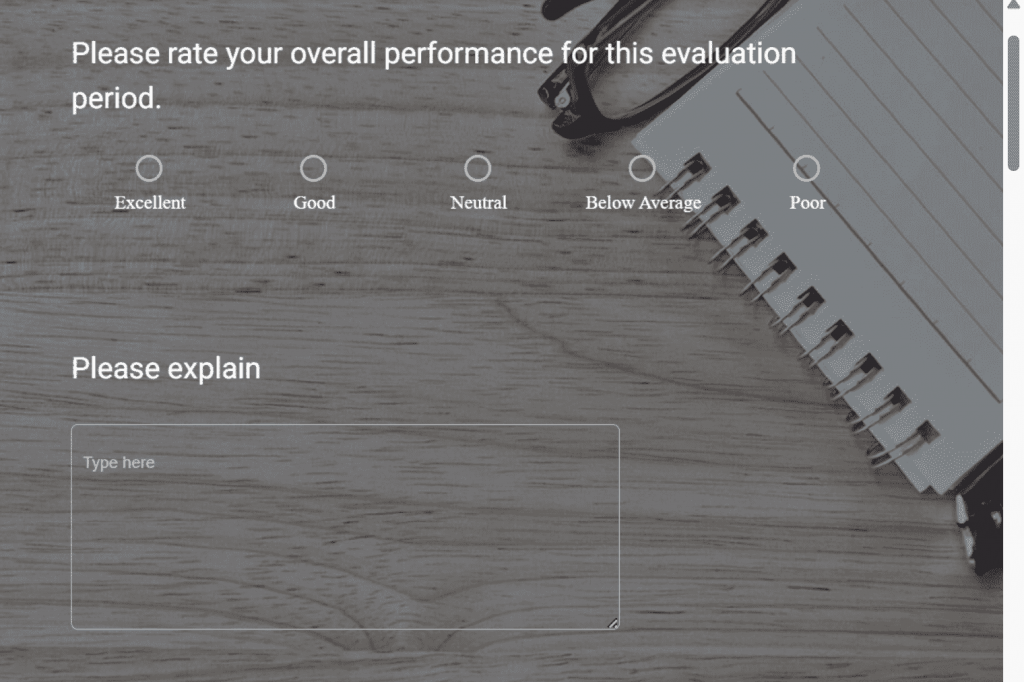
Questions to Avoid
- “Why didn’t you do better?” (Blame-heavy and shuts down constructive dialogue.)
- “What’s your biggest weakness?” (Cliché, overused, and often produces rehearsed answers instead of honesty.)
- “Do you like your job?” (Too vague; doesn’t provide actionable feedback.)
Example in Practice
A sales manager asked, “Which of your wins this quarter made the biggest impact, and what made it possible?” The employee highlighted closing a key client deal thanks to improved pitch materials and collaboration with marketing. This gave leadership a blueprint to replicate success across the team.
2. Role Satisfaction & Support
Strong performance is tied to role satisfaction and workplace support.
Smart Questions to Ask
9. Which aspects of your role give you the most energy?
10. Which responsibilities feel draining or misaligned?
11. Do you have the tools and resources you need to succeed?
12. If you could adjust one part of your role, what would it be?
13. How can the leadership team better support you day to day?
14. Do you feel your role plays to your strengths?
15. Are you getting enough opportunities to use your skills meaningfully?
16. What would make your day-to-day experience more satisfying?

Questions to Avoid
- “Are you happy here?” (too broad, leads to a yes/no)
- “Do you like your job?” (oversimplified, not actionable)
- “Is everything fine?” (surface-level, discourages depth)
3. Challenges & Barriers
Good leaders surface obstacles early and commit to removing them.
Smart Questions to Ask
17. What was your biggest challenge this period, and how did you work through it?
18. Were there recurring obstacles that slowed you down?
19. Which processes or workflows felt like friction points?
20. Where do you feel blocked from making progress?
21. How can I remove barriers for you?
22. What kind of support would make your work easier?
23. Are there skills or tools you wish you had to overcome recurring challenges?
24. What situations this period felt most frustrating?

Questions to Avoid
- “Why didn’t you meet this goal?” (blame-focused)
- “What problems did you create?” (negative framing)
- “Do you need help?” (too vague, often answered with “no”)
4. Future Growth & Career Aspirations
Retention and motivation improve when employees see clear growth paths.
Smart Questions to Ask
25. What skills do you want to build in the next 6–12 months?
26. Where do you see yourself contributing more in the future?
27. Are there projects or responsibilities you’d like to take on?
28. What career path do you envision for yourself over the next few years?
29. What support or resources would help you grow faster?
30. Who on the team (or outside of it) would you like to learn from?
31. Are there areas of the business you’d like more exposure to?
32. What role or project would stretch you in a good way?
33. How do you want your role to evolve in the next year?
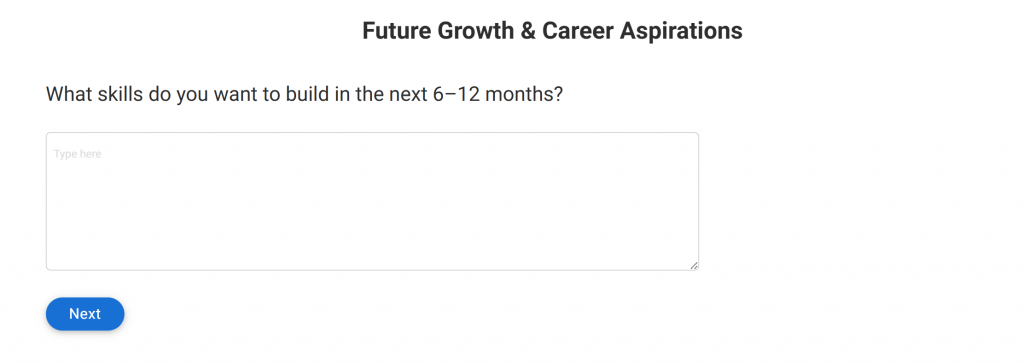
Questions to Avoid
- “Where do you want to be in five years?” (too vague, often unrealistic)
- “Do you want my job someday?” (awkward, shuts down honesty)
- “Are you looking to leave?” (destroys trust)
5. Organizational Alignment
Top-performing teams feel connected to the bigger mission.
Smart Questions to Ask
34. How do you see your work contributing to the department’s goals?
35. Do you feel clear on the department’s top priorities right now?
36. Where do you think your team is creating the most impact?
37. Are there areas where you feel disconnected from department strategy?
38. What part of our mission or values resonates most with you?
39. What would help you feel more connected to the bigger picture?
40. How do you see the department living up to its stated values?
41. Where do you see opportunities for your team to better align with company goals?
42. What recent company wins felt most meaningful to you personally?
Leverage & tweak this quick template to take department performance review:
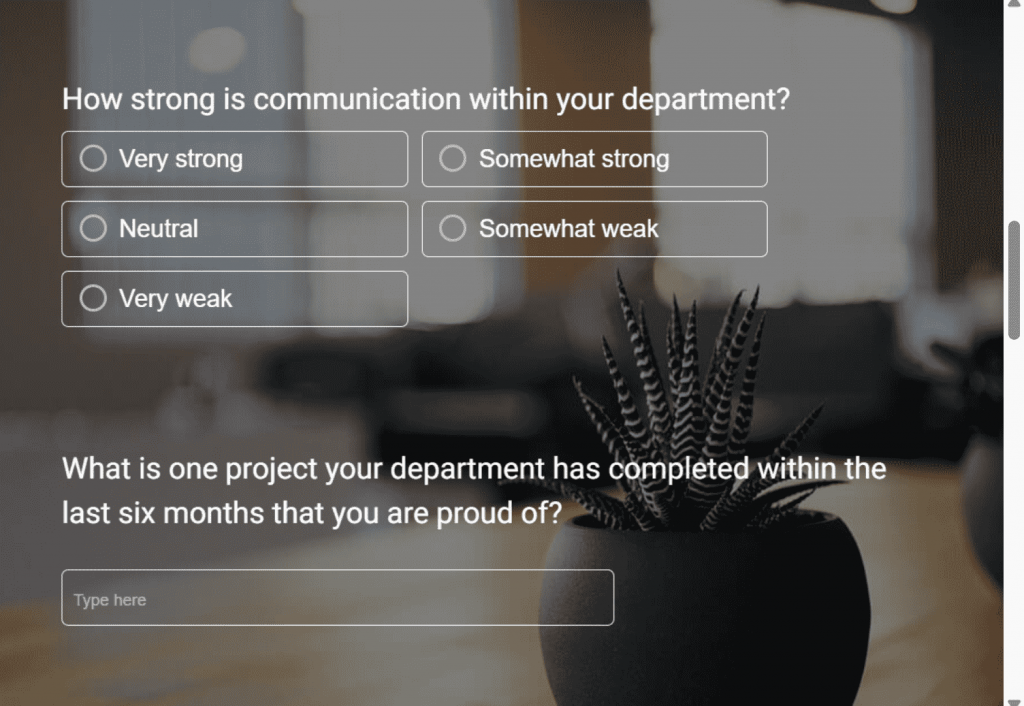
Questions to Avoid
- “Do you know the company mission?” (tests memory, not alignment)
- “Are you committed to the company?” (binary, creates defensiveness)
- “Do you agree with leadership’s strategy?” (pressures for compliance)
6. Leadership & Manager Feedback
Strong leaders model openness by asking for feedback themselves. This creates trust and demonstrates accountability.
Smart Questions to Ask
43. How supported do you feel by your manager?
44. What could your manager do differently to make your work easier or more effective?
45. Is there anything your manager should start, stop, or continue doing as a leader?
You can use this supervisor performance review template:
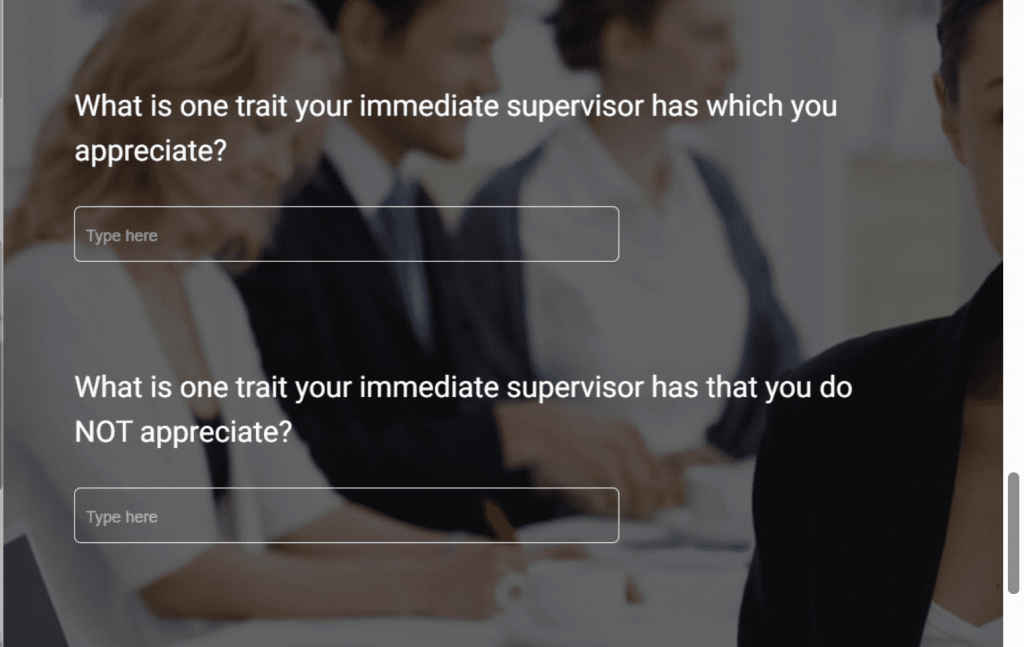
Questions to Avoid
- “Am I doing a good job as your manager?” (pressures employees to reassure you)
- “Do you think leadership is failing?” (creates fear and defensiveness)
- “Do you trust me?” (forces a yes/no, rarely honest)
360-Degree Performance Review Questions
A 360-degree review gathers perspectives from managers, peers, and direct reports, creating a more complete view of performance. For executives and senior leaders, it also signals a culture of openness and accountability — employees see that feedback flows in all directions, not just top-down.
For Peers
- How does this person contribute to team success?
- In what ways does this person strengthen collaboration?
- How do coworkers feel about working with this employee?
- How reliable is this person when others depend on them?
- What unique value does this person bring to the group?
For Direct Reports (About Their Manager)
- How clear is your manager when setting expectations?
- In what ways does your manager support your growth and development?
- How effectively does your manager communicate important updates?
- What could your manager do differently to make your work easier?
- How well does your manager recognize and celebrate contributions?
For Managers (About Employees)
- What impact has this person had on team goals?
- How has this person shown initiative or leadership potential?
- What areas could they develop further for greater impact?
- How does this person embody company values in their work?
- Where have they grown most since the last review?
Here is an easy template for you to conduct 360-degree performance reviews:
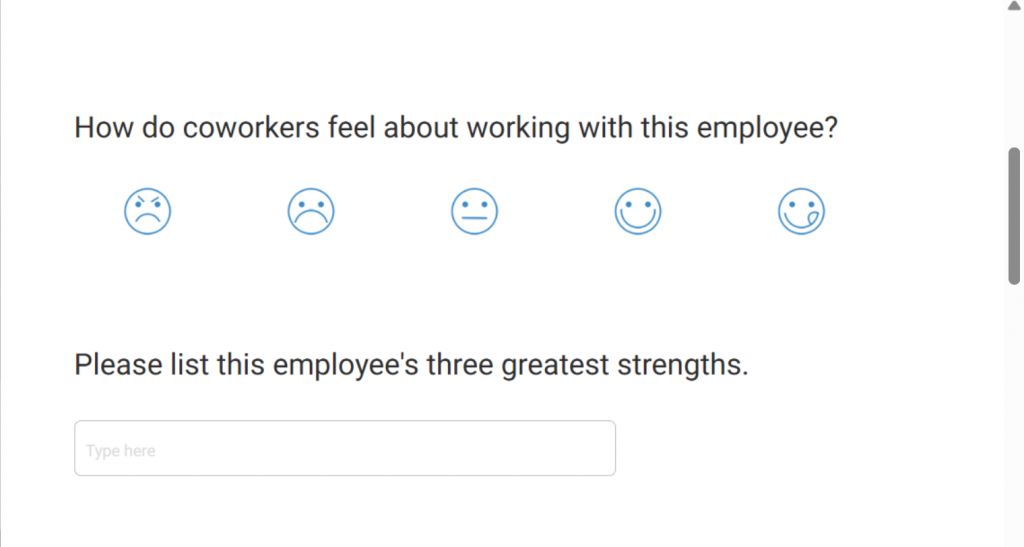
5 Regular Pulse-Check Questions for Performance Reviews
Performance reviews shouldn’t feel like one-off, high-stakes conversations. The most effective leaders weave in short, recurring “pulse check” questions to ensure employees feel supported and heard throughout the year. These performance review questions are lighter than full review prompts, but they keep communication open and make the formal review less intimidating — because feedback has been ongoing.
Pulse checks in a performance review context serve two purposes:
- They help managers catch issues early before they grow into bigger problems.
- They reinforce that leadership cares about the day-to-day experience, not just results on paper.
Below are pulse-style questions that work well when integrated into performance reviews, either at the start to “warm up” the conversation, or at the end to keep momentum going.
- How has your overall experience at work felt since our last review?
- What’s one thing you’ve been most proud of recently?
- What’s been your biggest challenge this cycle?
- Do you feel you have the resources and support you need to succeed?
- What’s one change that would make your work experience better moving forward?
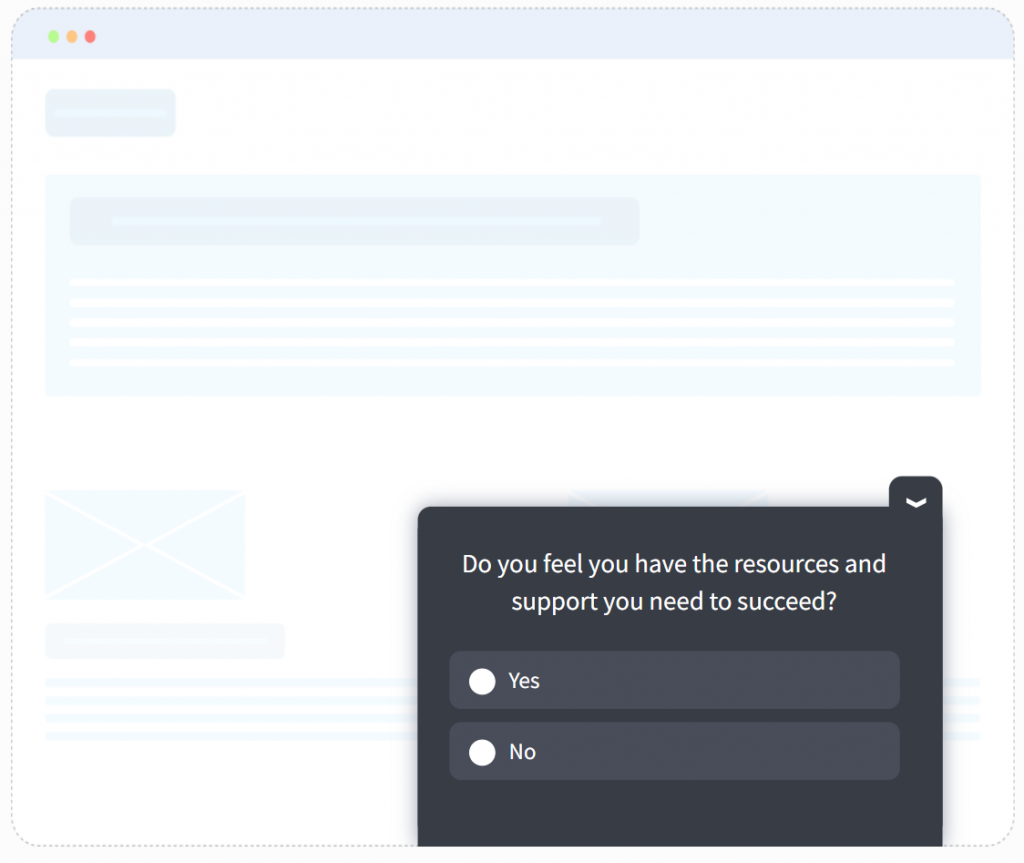
How to Turn Questions Into Conversations and Action
Asking the right questions is only half the battle. To run performance reviews that drive change instead of sitting in a file, you need a repeatable process. Follow this step-by-step playbook:
Step 1. Choose Your Tool
Before sending a single question, decide where and how you will capture answers and actions. The right survey tool prevents reviews from becoming scattered notes. Look for:
- Branching logic or conditional flows, so employees only see relevant follow-ups.
- Pre- and post-survey scheduling, so you can gather input before and confirm actions after.
- Integration with HR or performance systems, so nothing is lost.
Your review process depends on how and where you capture answers. One tool rarely covers every scenario, so match the tool to the type of review:
- For Structured, Long-Form Reviews: Use survey platforms like ProProfs Survey Maker for their quick & easy AI survey builders. These work well when you need branching logic, detailed questionnaires, and results delivered via email or integrated into HR systems. Here’s a complete guide for you to create your performance review surveys with AI.
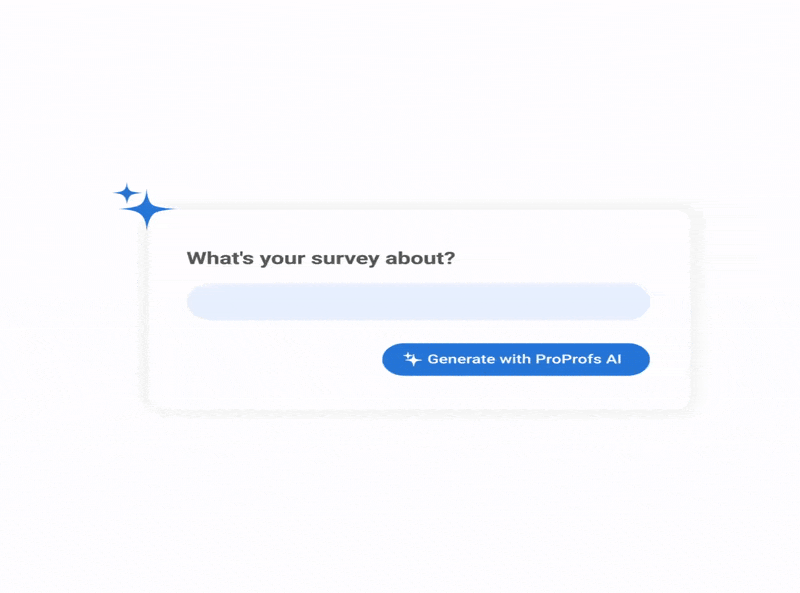
- For Regular Pulse Checks & Quick Feedback: Use microsurvey tools like Qualaroo, which let you collect short, focused responses inside chat apps, web apps, or internal platforms. These are ideal for lightweight follow-ups and real-time feedback. Here’s a quick video for you to create an in-context survey:
How to apply: Decide whether your immediate need is a full performance review survey or a quick pulse-check. Most teams benefit from using both—one formal tool for reviews and one lightweight tool for regular check-ins that helps gauge employee emotions using AI sentiment analysis and extensive reporting.
Step 2. Warm Up with a Pre-Review Survey
Send a short survey one week before the review. This gives employees time to reflect and ensures the meeting starts with substance.
Checklist for your pre-review employee evaluation survey:
- 2–3 questions on achievement
- 2–3 questions on challenges or support needs
- 2–3 questions on career aspirations
- 1 open-ended “Anything else you want to cover?”
Keep it short and focused.
Step 3. Run the Review Conversation
Use the survey results as your roadmap, not a script. The goal is a meaningful conversation, not box-checking.
Conversation flow:
- Start with achievements to set a positive tone.
- Explore challenges and strengths in depth, using follow-ups.
- Stay flexible; if a critical issue comes up, address it fully before moving on.
- Document insights and next steps as you go.
Step 4. Capture Actions in Real Time
Every review should end with a set of clear, agreed-upon actions. Do not leave items vague.
| From Question | Possible Insight | Action |
|---|---|---|
| “Which part of your role drains you most?” | Reporting feels like busywork | Automate reports with a dashboard |
| “What skills do you want to build?” | Wants to learn data analysis | Assign analytics project + short training |
| “What support would help you most?” | Needs clearer project handoffs | Introduce standardized kickoff checklist |
Aim for at least two to three concrete commitments per review.
Step 5. Balance Talking and Listening
The most effective reviews follow the 70/30 rule: employees should do about 70 percent of the talking, managers 30 percent.
- Ask questions.
- Listen fully.
- Summarize what you heard.
- Confirm the takeaway.
Example: “So what I’m hearing is that sprint interruptions make it hard for you to focus. Let’s try longer deep-work blocks next sprint. Did I capture that correctly?”
Step 6. Close the Loop Immediately
Reviews often fail because follow-up is left vague. End each session by locking down next steps.
Checklist:
- Share the action plan within 24 hours.
- Schedule a follow-up meeting 30–60 days out.
- Send a short pulse survey after 30 days to check progress.
Do these before the review ends so nothing slips through.
Mini Workflow Template
- Pre-review survey (sent 7 days before)
- Review conversation (guided by survey, documented live)
- Action plan (2–3 commitments agreed and shared instantly)
- Follow-up survey (sent after 30 days)
- Check-in meeting (review progress, adjust, and repeat)
FREE. All Features. FOREVER!
Try our Forever FREE account with all premium features!
Training, Development, and Follow-Up
A performance review is not the end of the process. It is the beginning of action. To make the review meaningful, you must translate feedback into development goals, support those goals with resources, and follow up consistently.
1. From Feedback to Development Goals
Feedback that is not turned into a goal will be forgotten. Rewrite every action item from the review as a SMART goal (Specific, Measurable, Achievable, Relevant, Time-bound). You can set your employees’ smart goals using a performance management tool.
- Weak goal: “Improve communication skills.”
- Strong goal: “Complete a presentation workshop and lead one team meeting within 60 days.”
What to Do: At the end of the review, go through each action item and rewrite it in SMART format so expectations are clear.
2. Building a Growth Plan
Employees want to see how today’s conversation connects to their future. A simple one-page plan can give that clarity.
The plan should include:
- Current strengths: the abilities they already use well.
- Target skills: the next capabilities to develop.
- Activities: training, projects, or mentoring that will build those skills.
What to Do: Fill out this plan immediately after the review and revisit it every quarter.
3. The First Seven Days Matter Most
Momentum drops quickly if nothing happens after the review. Use the first week to prove that change is underway.
7-Day Checklist:
- Day 1: Send the documented action plan.
- Day 2–3: Share links to training resources or project details.
- Day 4–5: Schedule sessions with mentors or set up workshops.
- Day 7: Confirm responsibilities and send a short progress update.
What to Do: Treat this week as an extension of the review. Do not leave tasks open-ended.
4. Keeping Progress on Track
Development requires ongoing checkpoints, not just annual conversations. Use a mix of meetings and surveys to track progress.
- Weekly or bi-weekly one-on-one meetings: Review progress on agreed goals.
- Monthly pulse surveys: Ask short questions such as “Is your development plan on track?”
- Quarterly updates: Review the growth plan and adjust as needed.
What to Do: Use your chosen survey tool to automate reminders and keep tracking consistent.
5. Connect Growth to Organizational Support
Employees feel more motivated when they see the company is actively supporting their development. Link each goal with at least one organizational resource.
Examples of Support:
- Training budgets or paid courses
- Internal workshops and knowledge-sharing sessions
- Mentorship or shadowing opportunities
- Stretch assignments that align with company priorities
What to Do: For every development goal, attach a resource from the organization so progress feels achievable and supported.
Common Pitfalls That Break Performance Reviews
Even well-designed reviews can fail if managers fall into predictable traps. Most of these mistakes come from either lack of preparation or lack of follow-through. Avoiding them is as important as asking the right questions.
| Pitfall | Why It Breaks Reviews | What To Do Instead |
|---|---|---|
| Treating Reviews as One-Time Events | Annual or biannual reviews feel disconnected from real work and quickly lose impact. | Use reviews to set direction, then reinforce progress in regular one-on-ones and quick pulse surveys. |
| Asking Too Many Questions | Long surveys create fatigue and encourage shallow answers. | Keep pre-review surveys to 8–10 focused employee evaluation questions. Use the meeting for deeper exploration. |
| Focusing Only on Problems | A negative tone makes employees defensive and discourages honesty. | Balance the conversation. Start with achievements, then challenges, then growth opportunities. |
| Leaving Action Items Vague | Vague notes like “improve collaboration” give no clear path forward. | Translate feedback into SMART goals and confirm each goal with the employee before ending the review. |
| Ignoring Systemic Issues | Process or resource problems stay unresolved, leading to frustration and mistrust. | Separate individual challenges from systemic blockers. Escalate bigger issues and keep employees updated on fixes. |
| Not Closing the Loop | Reviews disappear into files, so employees see no real change. | Always share a written plan within 24 hours, schedule a 30–60 day follow-up, and run a pulse-check survey to confirm progress. |
Using Automation and AI
Performance reviews work best when they feel personal, but that does not mean every step must be manual. Automation and AI can reduce the workload, improve consistency, and give managers more time for meaningful conversations. The key is to use technology as an assistant, not a replacement.
1. Automating Surveys and Reminders
Logistics often derail reviews. Surveys are sent late, employees delay responses, and HR spends hours chasing data.
How Automation Helps:
- Schedule pre-review and post-review surveys automatically.
- Send reminders only to employees who have not responded.
- Push results directly into your HR system.
Example: Your survey maker platform can send pre-review surveys 7 days in advance, send reminders 2 days before, and deliver results to managers without manual effort.
2. Building Smarter Surveys with AI
Choosing the right questions takes time. AI survey builders can draft tailored questionnaires in minutes by pulling from best practices and past responses.
How AI Helps:
- Generate survey questions aligned to company goals or role types.
- Suggest branching logic so employees only see relevant follow-ups.
- Adapt surveys over time based on past response patterns.
Example: An HR team asks an AI survey builder for “10 questions to uncover career aspirations for mid-level engineers.” The tool generates a set of role-specific questions, saving hours of manual drafting.
3. Summarizing Feedback with AI
Managers often receive long, unstructured answers that are hard to digest. AI can turn these into actionable insights.
How AI Helps:
- Highlight recurring strengths and challenges.
- Summarize free-text answers into bullet points.
- Flag areas that may require immediate support.
Example: An AI assistant provides a one-page summary of survey answers so the manager enters the review with clarity, not raw data.
4. Turning Conversations Into Action Plans
Good discussions often fade into vague notes. AI can format them into structured goals.
How It Works:
- Convert meeting notes into SMART goals automatically.
- Organize commitments into 30, 60, and 90-day plans.
- Share the plan instantly with the employee.
Example Table: Automated Action Plan Output
| Area | Goal | Timeline | Support |
|---|---|---|---|
| Reporting | Automate monthly dashboard | 30 days | Manager + Analytics team |
| Skill growth | Complete Excel course and apply in Q2 report | 60 days | Training budget |
| Team impact | Lead client presentation | 90 days | Mentor support |
Note: Stay Human-Centered
Technology can prepare, track, and summarize, but it cannot replace trust, empathy, or judgment. Use AI to streamline setup and follow-up, while keeping the actual review conversation fully human.
Turning Reviews Into Results: How Legacy Research Made Their Trainings Efficient, Measurable & Consistent
Real-world examples show how structured reviews, training, and the right tools can turn feedback into measurable improvement. Here is one snapshot you can draw inspiration from.
The Challenge: The company relied heavily on Slack for training and communication, which quickly became a bottleneck. Employees struggled to find past updates and training material, and new hires lacked a structured way to access knowledge. Managers also lacked consistent methods to track progress or gather feedback on training effectiveness.
The Solution: Legacy Research adopted a training, assessment & survey suite.
- Training Maker allowed managers to create structured training programs.
- The Knowledge Base gave employees a self-serve hub where they could log in anytime to find what they needed without combing through old messages.
- Quiz and Survey Maker helped the Learning & Development team gather feedback, identify knowledge gaps, and adjust materials quickly.
The Result: Within months, the team saw measurable performance improvements. Employees who had previously struggled to meet quality goals improved after using the new system. Training became faster to build, easier to access, and better aligned with employee needs.
FREE. All Features. FOREVER!
Try our Forever FREE account with all premium features!
Make Reviews Work for You
Most performance reviews fail because they are treated as formalities. The questions are vague, the process is inconsistent, and follow-up rarely happens. But when you ask the right questions, turn them into conversations, and follow through with training and support, reviews become one of the
Done right, performance reviews improve performance, build trust, and help employees see a future inside the organization. A simple way to make this process even more effective is to complement formal reviews with quick, lightweight check-ins. In-context microsurveys enable you to capture feedback in the flow of work, turning reviews into a continuous conversation rather than a once-a-year event.
Next Step for You: Utilize the ready-to-use templates for complete questionnaires and question sets given above, and start redesigning your next review cycle. See how survey tools and automation can fit into your process and drive real improvement.
Frequently Asked Questions
What are the 5 words performance review?
The “five words” performance review is a quick exercise where employees or managers describe performance in just five words. It forces clarity, highlights perceptions, and can reveal blind spots. While not a full review, it can be an engaging way to start deeper conversations about growth.
What are four questions a manager should be asking when reviewing performance indicators?
When reviewing performance indicators, managers should ask: What is working well? Where are results falling short? What external factors influenced these numbers? What actions can we take to improve? These questions connect data to context and keep the focus on solutions rather than just measurement.
What not to say during a performance review?
Avoid vague statements like “You need to do better” or comparisons such as “Why can’t you be more like your teammate?” Negative or unclear comments discourage honesty and progress. Instead, focus on specific examples, actionable suggestions, and questions that invite collaboration on solving challenges constructively.
Why use surveys with branching logic for performance reviews?
Surveys with branching logic keep reviews efficient and relevant. Employees only see questions that apply to their role or situation, which reduces fatigue and improves answer quality. Managers then enter the review with better insights and can spend the meeting exploring meaning instead of clarifying basics.
FREE. All Features. FOREVER!
Try our Forever FREE account with all premium features!

 We'd love your feedback!
We'd love your feedback! Thanks for your feedback!
Thanks for your feedback!






